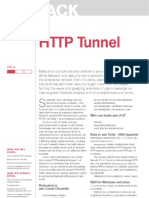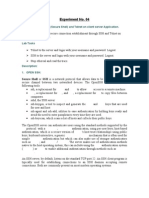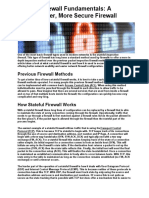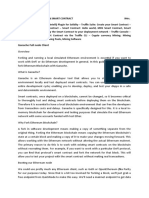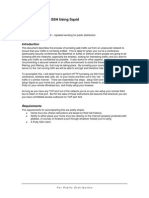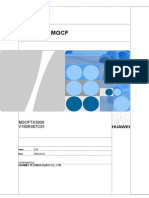HTTP Tunnel
HTTP Tunnel
Uploaded by
DarkWolf_TrueCopyright:
Available Formats
HTTP Tunnel
HTTP Tunnel
Uploaded by
DarkWolf_TrueOriginal Title
Copyright
Available Formats
Share this document
Did you find this document useful?
Is this content inappropriate?
Copyright:
Available Formats
HTTP Tunnel
HTTP Tunnel
Uploaded by
DarkWolf_TrueCopyright:
Available Formats
42 HAKIN9
ATTACK
1/2009
S
urfing the web is one thing users are
allowed to do inside a company. What
does it technically mean to surf the web?
To access the WWW there must be at least t wo
open ports for allowed outbound connections.
Port 80 is used for HTTP and Port 443 is used for
HTTPS (see Table 1. for essential port numbers).
It is always easy to create a securit y
branch from inside to outside. Covert Channel
Technologies are wide spread and simply every
user can make use of it because of easy to
understand How-Tos. 100 procent of securit y can
not be achieved, but what you can do is to make
it dif ficult by taking counter measures. According
to Covert Channels, if there is any traf fic allowed,
the protocol available can be used as transport
medium and due to this, it is very dif ficult to detect
that traf fic.
What I want to demonstrate, is how to hide
tracks using HTTPTunneling techniques. I will
introduce two user friendly tools and some
measures you can consider to prevent tunneling.
In our case, traf fic looks like normal HTTP/HTTPS
Traf fic. If there are any anomaly detection systems,
it could be that httptunnel traf fic produces alert
events.
Motivation to
use Covert Channels
Surf on denied websites,
chatting via ICQ or IRC,
MICHAEL SCHRATT
WHAT YOU WILL
LEARN...
How to establish HTTP tunneling.
Which tools are in the wild.
What the purpose of tunneling is,
and what possibilities of covert
channel techniques there are.
WHAT YOU SHOULD
KNOW...
How to use the Linux & Windows
operation system.
Tunneling basics.
Knowledge about TCP/IP
networks, especially Layer 4 & 5.
How to use a network analysing
tool, for example Wireshark,
tcpdump.
access private servers in the internet for
remote administration,
downloading files with filtered extensions,
downloading files with malicious code.
Who can make use of it?
Hackers,
disgruntled employees,
users from the internal network.
Easy to use Tools - GNU ttptunnel
Information extracted from http://www.nocrew.org/
sof tware/httptunnel.html
httptunnel creates a bidirectional virtual
data connection tunneled in HTTP requests. The
HTTP requests can be sent via an HTTP proxy if
so desired.
This can be useful for users behind restrictive
firewalls. If WWW access is allowed through HTTP
proxy, it is possible to use httptunnel and, say,
telnet or PPP to connect to a computer outside the
firewall. httptunnel is written and maintained by
Lars Brinkhof f.
Httptunnel is also available as windows binary.
SSH for Windows and Linux
A way to access a shell was former made by the
use of telnet.
Telnet is now considered as unsecure due
to plaint text transfer. It is possible to snif f telnet
traf fic on the net work to get usernames and
Difficulty
HTTP Tunnel
Most of all companies only provide a very restrictive environment.
While Network and Security Adminstrators do their job, securing
the enterprise network from intruders, users are trying to
compromise perimeter security to get more than is allowed.
Surfing the www and googling provides a huge knowledge on
how to greak firewalls, proxies, anti-virus appliances and so on.
43 HAKIN9
HTTP TUNNEL
1/2009
passwords of dif ferent users. On Linux
versions af ter januar y 2002 you already
have OpenSSH installed.
SSH has replaced telnet and has
improvments like encrypted traf fic. SSH is
also called Secure Shell.
Not only encrypted traf fic is a reason
to use SSH, but also secure file transfer
and an enhanced authentication facilit y.
For Windows machines it is possible to get
OpenSSH as Windows Binary.
An already wide spread and known
SSH client for windows and unix systems
is Putt y.
Putt y is a free available graphic tool
which implements telnet and SSH.
Main Problem of Transfer
The most available ports allowed for
outbound connections are as mentioned
before port 80 for unencrypted HTTP traf fic
Table 1. Essential Port Numbers
Port Number Service
20 21 / TCP FTP
22 / TCP SSH
23 / TCP Telnet
25 / TCP SMTP
53 / TCP UDP DNS
80 / TCP HTTP
110 / TCP POP3
143 / TCP UDP IMAP
161 162 / TCP UDP SNMP
443 / TCP HTTPS
1080 / TCP SOCKS Proxy
3128 / TCP Squid Proxy
5190 / TCP ICQ AOL
Messenger
6660 6669 / TCP IRC
Figure 1. Network Perimeter Security
Web Server Mail Server DNS Server
DMZ
nternet Permimeter
NDS
Proxy Server Firewall
Legality and Ramifications
Without addressing every country's laws, there can be sanctions and legal proceedings if using
covert channels in corporate networks. Read the companies policies detailed to become familiar
with. Be warned and do not use covert channels just for fun. There may be corporate agreements to
tunnel data to business partners, for example. This is to ensure that nobody else can listen to your
transmission of sensible enterprise information.
Covert Channel Techniques
Covert Channel Hacking is an insider attack to inititate connections from the trusted network to
an untrusted network. Dif ferent types mentioned below:
Direct Channel Techniques
ACK Tunnel
TCP Tunnel (telnet, ssh)
UDP Tunnel (snmp)
ICMP Tunnel
Proxified Channel Techniques
Socks SSL Tunnel
HTTPS Tunnel
DNS Tunnel
FTP Tunnel
Mail Tunnel
Warning
Using Covert Channels to transfer data out of your companie's network must not be a legal activity
(see Legality and Ramifications. for more information).
Perimeter Security
Perimeter Security comprises Firewall Technologies, Packet Filtering, Stateful Inspection,
Application Proxies, Virtual Private Networks (VPN), HTTP Proxies, Security Gateways, Intrusion
Detection (IDS), Intrusion Prevention (IPS) up to Bollards, Fencing, Vehicle Barriers, Security Controls
(see Figure 1).
GNU What is it?
GNU is an operating system which consists
only free software. The GNU Project includes
known tools like GCC, binutils, bash, glibc and
coreutils. GNU GPL is a licence which can be
used for software to mark it as free software.
It is called Gerneral Public Licence and has
the might to forbid giving any restrictions on
programs. Futher information can be found at
http://www.gnu.org
IANA
See http://www.iana.org/ for more information.
ATTACK
44 HAKIN9 1/2009
HTTP TUNNEL
45 HAKIN9 1/2009
and port 443 for encrypted transfer or
HTTPS.
Lets assume, we want to access por t
22 for SSH on our ser ver in the internet.
Due to firewall restrictions, it is not
possible to connect directly on por t 22 to
open a shell.
Solving the
problem with httptunnel
Have a look at figure 5. to see how our
tunnel will go through firewalls and proxies.
Bypassing content filtering and signature
based detection systems due to encryption
provided by SSH.
What the main job belongs to is to
establish the HTTP tunnel, connect to a
shell through the tunnel and what you get
is an SSL Traf fic based HTTP tunnel with
encryption, authentication and integrit y.
Needed Environment
Inside and Outside
Enterprise Side:
Workstation with internet access, at
least one service must be allowed for
outbound connections,
httptunnel client,
ssh client.
Home Side:
Workstation with internet access,
httptunnel server with correct
configuration,
ssh server daemon with correct
configuration (Configuration described
in Configure of Services),
Any service running which you want to
access remotely.
Configure of Services
Configure ht tptunnel Ser ver. Set ting
up a tunnel is ver y easy. Httptunnel
is a command-line tool with several
functions.
Belonging to the environment setup
described at Needed Environment Inside
and Outside there are some possibilities
that could be used to start and configure
httptunnel.
Commands:
hts forward-port localhost:
22 443 (tunnel port 443 to 22), or the
same
hts -F localhost:22 443
If you do not have root rights you can
use unprivileged ports above 1024, for
example
Figure 4. Transfer Problem
DMZ
PROXY Server
WEB Server
SSH Server
NTERNET
Port 22
Port 80 Port 80
Figure 3. SSH Client Linux
Figure 2. SSH Client Putty Figure 5. Solved Transfer Problem
DMZ
PROXY Server WEB Server
Tunnel Server WEB Server
HTTP Tunnel
Allowed Traffic
Port 443
Port 443
Port 80
Port 443
Port 80
HTTP Request
Port 22
NTRANET
HTC&SOCKS
HTTP Client
Port
Forwarding
Port 443
ATTACK
44 HAKIN9 1/2009
HTTP TUNNEL
45 HAKIN9 1/2009
hts forward-port localhost:22
40000
hts help
If our httptunnel server is up and running, it
should look like described in Figure 7.
In Addition, our defined port 443 should
be LISTENING.
Configure SSH Service
To provide full compatibilit y with your tunnel
make the changes listed in Listing 1.
Final Step: Open Tunnel and
connect to the SSH Server
Most work is done, and the final step is to
open our tunnel. So, we need to be familiar
with the httptunnel client. The simplest way
to open a tunnel is:
htc --forward-port 10001
192.168.11.240:443
So, we say, for ward local por t 10001 to
our ht tptunnel ser ver with ip address
192.168.11. 240 on por t 443. We are able
to prove the established ht tp tunnel by
using netstat. Por t 10001 has to be in
an LISTENING state. If so, star t your ssh
client and connect to por t 10001 on
localhost:
putty -P 10001 root@localhost or,
ssh -p 10001 root@localhost or
use -l for login _ name parameter.
See Figure 3. for available SSH
parameters.
Enter your credentials if required. From
now, you have opened a HTTP Tunnel and
connected through it to use the server's
shell. In that way, you are only able to use
that opened shell to run commands on the
server.
You could use SCP instead, to move
data over the tunnel . But that should not
be the onl y thing we want to achieve.
Now, we are going to setup a local
proxy and use it for other applications
like IRC, Skype. Ever y application that
has the abilit y to use a SOCKS Proxy is
welcome.
You are able to use your private email
server for sending mails or access your
POP, IMAP Server through your tunnel. That
is only the question how you make use of
port forwarding with your ssh client.
More Practice
Create your own SOCKS Proxy
htc forward-port 10001
192.168.11.240:443 (open tunnel),
putty -D 1080 -P 10001
root@localhost (connect to shell
Figure 8. HTC & Proxy Port
Figure 7. HTS Verification
Figure 6. HTS Help Screen
Figure 9. Firefox Proxy Settings
ATTACK
46 HAKIN9 1/2009
HTTP TUNNEL
47 HAKIN9 1/2009
using local tunnel port and select 1080
as dynamic forwarded port),
configure your browser like displayed in
Figure 9.
I would recommend to use Firefox with any
Proxy Management Extension. In that way
you are able to quickly switch to other Proxy
Settings.
You can use your created SOCKS Proxy
with all other apllications that are able to
set SOCKS Proxy Settings, for example:
Skype, IRC, P2P Sof tware, Browser.
To verif y if your SOCKS Proxy works
correctly, do the following. Surf the
net without proxy and choose Direct
Connection in your Proxy Settings of your
browser. Go to a website, for example, http:
//whatismyip.com and write down the IP
Address printed out.
Next, choose your SOCKS Proxy again,
and require your used IP Address again. You
will see your IP Address from your own server
in the internet. So, your Proxy is working.
You could also use htc (httptunnel
client) to connect through a proxy and
provide credentials for authentication, or
define an own User-Agent.
Your are also able to access your
internal devices at home. Just t ype their
internal ip address into the address field in
your browser.
This has an big advantage, because
of just opening one port for incomming
connections and using it for your httptunnel
server.
Use VNC for remote
administration
Configure VNC Ser ver at your Ser ver
outside. Default Por ts for VNC are
5900/TCP and 5800/TCP and set
your display number. I will use 64
as display number. In that case, the
corrected por t numbers are 5964/
TCP and 5864/TCP,
htc forward-port 10001
192.168.11.240:443,
putty -L 5964:127.0.0.1:5964 -
X -P 10001 root@localhost (-L
for ward localpor t 5964 for vnc client,
and enable X11 For warding with -X),
Start your VNC Client and connect
to localhost:64 (localhost:
<displaynumber>).
Use any SMTP
Server for mailing
There must be a SMTP Server running
outside,
htc forward-port 10001
192.168.11.240:443,
putty -L 666:
<smtpserver>:25 -P 10001
root@localhost,
Disadvantages of a HTTP tunnel without SSH
No encryption, it is possible to sniff your connection,
No Privacy, anybody can use your tunnel,
Provides no integrity, your stream could be altered,
you can only get one established connection through your http tunnel.
Tunnel Security
Provide Integrity, Privacy and Authentication if you use HTTP Tunnel and SSH together.
HTTP-CONNECT
The HTTP CONNECT method can be used with a proxy that can dynamically switch to tunnel mode.
Figure 11. IP with enabled Tunnel
Figure 10. IP Without Proxy Without Tunnel
Figure 12. HTC Help Screen
ATTACK
46 HAKIN9 1/2009
HTTP TUNNEL
47 HAKIN9 1/2009
configure your mail client to use
localhost:666 as Outgoing Mailserver.
Counteractive Measures
Disallow unimportant traf fic (Listing 2.),
close unneeded ports and stop
unnecessary services,
use Stateful Inspections to prevent ACK
Tunneling,
set timeouts for connections to prevent
Covert Timing Channels,
use Content Filtering,
use HIDS and NIDS,
use Proxies with Authentication,
disallow HTTP-CONNECT Queries,
make use of Anti Virus Sof tware and
Anti Spyware Sof tware,
inspect logfiles an a regularly basis,
have a detailed look at suspicious
traf fic,
monitor your network and build
statistics of traf fic.
Conclusion
You see, building up a tunnel is not very
difficult. You only need little experience
and understanding. httptunnel is also a
recommended tool in penetration testing.
You can hide your tracks to ensure not to be
protected by any perimeter security devices.
Altough, there are some methods of anomaly
detection measures, for example, to compare
incomming http traffic to outgoing. A security
baseline would be that incomming http traffic
is likely to be higher than outgoing. If you have
got that specific anomaly, this could be hidden
traffic. Also the encryption of the SSL Tunnel
exhibits barriers in detecting hidden traffic.
There are countries where it is not
allowed to use encryption. And once
again, you can implement all measures for
making it difficult to attack, but there may
be further security branches due to wrong
configurations, unknown signatures, covert
channels, user ignorance and so forth. Finally,
I ask you, not to use above mentioned
techniques for illegal matters. Before
making use of it, get familier with provisions
of the countrie's law.
Listing 1. SSH Configure
/etc/ssh/sshd_cong
AllowTcpForwarding yes
#Species whether TCP forwarding is permitted
GatewayPorts yes
#Species whether remote hosts are allowed to connect to ports forwarded for the
client.
X11Forwarding yes
#The connection to the X11 display is auto-matically forwarded to the remote side in
such a way
#that any X11 programs started from the shell (or command) will go through the
encrypted
#channel, and the connection to the real X server will be made from the local machine.
PermitTunnel yes
#Support for VPN Tunneling
Listing 2. Sample Firewall Ruleset
# drop suspicious packets and prevent port scans
iptables -A INPUT -p tcp --tcp-ags ALL FIN,URG,PSH -j DROP
iptables -A INPUT -p tcp --tcp-ags ALL ALL -j DROP
iptables -A INPUT -p tcp --tcp-ags ALL SYN,RST,ACK,FIN,URG -j DROP
iptables -A INPUT -p tcp --tcp-ags ALL NONE -j DROP
iptables -A INPUT -p tcp --tcp-ags SYN,RST SYN,RST -j DROP
iptables -A INPUT -p tcp --tcp-ags SYN,FIN SYN,FIN -j DROP
# A Way to prevent ACK Tunneling, a new connection must be initiated with an SYN Flag
ON.
iptables -A INPUT -p tcp ! --syn -m state --state NEW -j DROP
# SYN-Flood Protection
iptables -N syn-ood
iptables -A INPUT -p tcp --syn -j syn-ood
iptables -A syn-ood -m limit --limit 1/s --limit-burst 4 -j RETURN
iptables -A syn-ood -j DROP
# Reject HTTP CONNECT Queries
iptables -I INPUT -p tcp -d 0/0 --dport 80 -m string --string "CONNECT" -j REJECT
# Limit Connections
iptables -p tcp -m iplimit --iplimit-above 2 -j REJECT --reject-with tcp-res
On the 'Net
http://www.gnu.org/ GNU Project,
http://www.iana.org/ Internet Assigned Numbers Authority,
http://www.iana.org/assignments/port-numbers/ List of Port Numbers,
http://www.nocrew.org/sof tware/httptunnel.html httptunnel sof tware,
http://www.neophob.com/serendipit y/index.php?/archives/85-GNU-HTTPtunnel-v3.3-Windows-
Binaries.htmlss.full.link httptunnel win32 binaries,
http://www.w3.org/Protocols/rfc2616/rfc2616.html RFC 2612, Hypertext Transfer Protocol
HTTP/1.1,
http://multiproxy.org/ Proxy Lists,
http://www.stunnel.org/ Stunnel,
http://www.ethereal.com/ Ethereal, Wireshark,
http://www.snort.org/ Snort IDS,
http://www.openssh.org/ OpenSSH,
http://sshwindows.sourceforge.net/ OpenSSH for WIndows,
http://openvpn.sourceforge.net/ OpenVPN,
http://www.net filter.org/ Iptables and Netfilter,
http://www.htthost.com/ TCP/IP through HTTP,
http://www.dnstunnel.de/ DNS Tunneling,
http://thomer.com/icmptx/ ICMP Tunneling,
http://www.ntsecurit y.nu/toolbox/ackcmd/ ACK Tunneling.
Michael Schratt
Michael Schratt deals with Network & Operational
Security, is an enthusiastic programmer and has big
skills in WebApplication Security. His basic job is to
maintain enterprise monitoring systems and endpoint
security on unix and windows machines.
Contact: mail@securityinside.info
You might also like
- Botnet BibleDocument89 pagesBotnet BibleGUy FawkesNo ratings yet
- What Is Telnet?Document3 pagesWhat Is Telnet?lalit KumarNo ratings yet
- How To Hack Remote Computer Using Ip AddressDocument4 pagesHow To Hack Remote Computer Using Ip AddressJeandelaSagesseNo ratings yet
- HTTP Tunnel 1Document6 pagesHTTP Tunnel 1Adailton CruzNo ratings yet
- Experiment No. 04: To Analysis The Secure Connection Establishment Through SSH and Telnet OnDocument7 pagesExperiment No. 04: To Analysis The Secure Connection Establishment Through SSH and Telnet OnAli AhmadNo ratings yet
- Methods To Bypass ISP Block of Any SiteDocument28 pagesMethods To Bypass ISP Block of Any SiteKrishna ShashankNo ratings yet
- ACN Chapter 5Document20 pagesACN Chapter 5hackermh862No ratings yet
- Lab Instructions Implementing Common Protocols and ServicesDocument49 pagesLab Instructions Implementing Common Protocols and Servicesnguyen le hoang vuNo ratings yet
- Port 80Document7 pagesPort 80Nada BrgNo ratings yet
- Section 7: Computer NetworksDocument11 pagesSection 7: Computer NetworksRaheel AhmadNo ratings yet
- How Do SSH, Telnet and Rlogin Differ?Document11 pagesHow Do SSH, Telnet and Rlogin Differ?Saorabh KumarNo ratings yet
- Session 3 - AuthenticationDocument17 pagesSession 3 - AuthenticationmunyakatimNo ratings yet
- VPN Security NotesDocument73 pagesVPN Security Notessergio_acunaNo ratings yet
- TelnetDocument3 pagesTelnetsabriaminNo ratings yet
- HOWTO - Anonymous Communication With Tor - Some Hints and Some Pitfalls (Update) - Uwe HermannDocument19 pagesHOWTO - Anonymous Communication With Tor - Some Hints and Some Pitfalls (Update) - Uwe HermannSascha Baumgartner100% (1)
- Internet Secure Tunneling: Implementation GuideDocument16 pagesInternet Secure Tunneling: Implementation Guidedyanne20No ratings yet
- Unit5ethereum WalDocument14 pagesUnit5ethereum Walseion vaneNo ratings yet
- Lease Financing of Bangladesh A DescriptDocument48 pagesLease Financing of Bangladesh A DescriptashifnahiyanNo ratings yet
- Closing Open Holes, System Security How To Close Open HolesDocument7 pagesClosing Open Holes, System Security How To Close Open Holescrosuperman1970No ratings yet
- Net CatDocument6 pagesNet CatKanishk Jha100% (1)
- Tunnel HTTP Thru SSHDocument6 pagesTunnel HTTP Thru SSHcretufiNo ratings yet
- BCS TB Tunnelling Applications PDFDocument4 pagesBCS TB Tunnelling Applications PDFitm.nakulNo ratings yet
- 11.2.4.7 Lab - Examining Telnet and SSH in WiresharkDocument9 pages11.2.4.7 Lab - Examining Telnet and SSH in WiresharkParthPatel100% (2)
- Setting Up A Proxy Server at HomeDocument5 pagesSetting Up A Proxy Server at Homeratnaraj_kanungoeNo ratings yet
- Unit 5Document26 pagesUnit 5RajinithanuNo ratings yet
- In Introduction To HTTP BasicsDocument21 pagesIn Introduction To HTTP BasicsAlice StateNo ratings yet
- How To Hack Remote Computer Using Ip AddressDocument4 pagesHow To Hack Remote Computer Using Ip AddressJeandelaSagesseNo ratings yet
- How To Hack Remote Computer Using Ip AddressDocument4 pagesHow To Hack Remote Computer Using Ip AddressJeandelaSagesseNo ratings yet
- TelnetDocument6 pagesTelnetshahramkarimi76No ratings yet
- 05 Task Performance 1 - ARG DDCDocument2 pages05 Task Performance 1 - ARG DDCwilnes.abelidoNo ratings yet
- FirewallDocument7 pagesFirewallAlrick BarwaNo ratings yet
- Dial Up and VPN ConnectionDocument13 pagesDial Up and VPN ConnectionIqfa IqaNo ratings yet
- Definition - What Does Telnet (TN) Mean?Document4 pagesDefinition - What Does Telnet (TN) Mean?sherwin cardozaNo ratings yet
- Computer Network Protocols and IPaddressDocument44 pagesComputer Network Protocols and IPaddressolive tabernaNo ratings yet
- Tor Network On DebianDocument6 pagesTor Network On Debiancharles.vissolNo ratings yet
- Chapter 10 - Securing The Web Environment: at A GlanceDocument9 pagesChapter 10 - Securing The Web Environment: at A Glanceghar_dashNo ratings yet
- Surf Jacking: "HTTPS Will Not Save You"Document11 pagesSurf Jacking: "HTTPS Will Not Save You"ArondeParon100% (1)
- Secure Telnet White PaperDocument10 pagesSecure Telnet White PaperManas Kumar NayakNo ratings yet
- Chapter 9 - Extending The Web Environment: at A GlanceDocument8 pagesChapter 9 - Extending The Web Environment: at A Glanceghar_dashNo ratings yet
- 11.2.4.5 Lab - Accessing Network Devices With SSHDocument11 pages11.2.4.5 Lab - Accessing Network Devices With SSHDragan Filipovic50% (2)
- A Brief History of SSH and Remote AccessDocument5 pagesA Brief History of SSH and Remote AccessWPineda82No ratings yet
- jrr89 - GhostbinDocument5 pagesjrr89 - GhostbinHitesh SinghNo ratings yet
- Web Technology UNIT-1Document20 pagesWeb Technology UNIT-1Yash TyagiNo ratings yet
- Placing Backdoors Through FirewallsDocument7 pagesPlacing Backdoors Through FirewallsSpyDr ByTeNo ratings yet
- Hiding Web Traffic with SSH: How to Protect Your Internet Privacy against Corporate Firewall or Insecure WirelessFrom EverandHiding Web Traffic with SSH: How to Protect Your Internet Privacy against Corporate Firewall or Insecure WirelessNo ratings yet
- Fort I Net Open PortsDocument14 pagesFort I Net Open PortsaboutpanuNo ratings yet
- 4 Communication ProtocolDocument14 pages4 Communication ProtocolMay Myat100% (1)
- TCP Wrappers UnwrappedDocument6 pagesTCP Wrappers Unwrappedapi-3696720No ratings yet
- 3.2.1 Protocols PDFDocument13 pages3.2.1 Protocols PDFDeewas PokhNo ratings yet
- Telnet HTTP FTPDocument11 pagesTelnet HTTP FTPRohit VermaNo ratings yet
- ManualDocument4 pagesManualEm ONNo ratings yet
- CN Unit 5Document17 pagesCN Unit 5drewgaming713No ratings yet
- Telnet and Remote LoginDocument5 pagesTelnet and Remote LoginBoobalan RNo ratings yet
- Web ProgrammingDocument206 pagesWeb Programmingalluri raghava rajuNo ratings yet
- Competitor: Virtual TunnelDocument14 pagesCompetitor: Virtual TunnelVitthal ChaudhariNo ratings yet
- 10-Network ProtocolsDocument49 pages10-Network ProtocolsShelaniejean LimNo ratings yet
- Name: Salim Tadvi Reg No: 201070042: Computer NetworksDocument5 pagesName: Salim Tadvi Reg No: 201070042: Computer NetworksSALIM TADVINo ratings yet
- Mpls Oam TutorialDocument74 pagesMpls Oam TutorialHeribertus BudhihartoNo ratings yet
- LTE System EngineeringDocument5 pagesLTE System EngineeringOmer AbdalazizNo ratings yet
- Intercell Build-In EPC User GuideDocument12 pagesIntercell Build-In EPC User GuideCarlos GuevaraNo ratings yet
- Metrodata Solutions CatalogueDocument16 pagesMetrodata Solutions CatalogueMetrodataLtdNo ratings yet
- Unify OpenscapeDocument78 pagesUnify OpenscapeCristian QuinteroNo ratings yet
- Questions From Chapter 7Document4 pagesQuestions From Chapter 7Syeda Wahida SabrinaNo ratings yet
- Technical Note Modbus Implementation Using 3gen DTU Pro V1.2Document33 pagesTechnical Note Modbus Implementation Using 3gen DTU Pro V1.2Cássio Marcel Corghi de CamposNo ratings yet
- 02 8.3.1.2 Packet Tracer - CCNA Skills Integration Challenge Instructions - ILMDocument12 pages02 8.3.1.2 Packet Tracer - CCNA Skills Integration Challenge Instructions - ILMIngrid RodriguezNo ratings yet
- Igcse Computer ScieneDocument70 pagesIgcse Computer ScieneGatika SuneelNo ratings yet
- COVR-C1203 A1 Manual v1.00 (WW)Document107 pagesCOVR-C1203 A1 Manual v1.00 (WW)aksNo ratings yet
- Cisco StepsDocument15 pagesCisco Stepssrikanth42No ratings yet
- ZXDSL 9806H ZTE BroadbandDocument392 pagesZXDSL 9806H ZTE Broadbandadmin engitechNo ratings yet
- Data Sheet 6ES7516-3FN01-0AB0: General InformationDocument9 pagesData Sheet 6ES7516-3FN01-0AB0: General InformationMarko VadasNo ratings yet
- Accedian NID User ManualDocument152 pagesAccedian NID User ManualWildman0150% (2)
- MikrotikDocument1,005 pagesMikrotikJan Holba67% (3)
- Avaya Aura® Session ManagerDocument8 pagesAvaya Aura® Session ManagerfarisNo ratings yet
- E1 and T1 Interface Cards (S30824-Q32-X and - X100) : OTN ManualDocument12 pagesE1 and T1 Interface Cards (S30824-Q32-X and - X100) : OTN Manual王志晓No ratings yet
- MG Networking l4 Perform SwitchingDocument17 pagesMG Networking l4 Perform SwitchinggarysamjonesNo ratings yet
- Internet Phone Adapter: With 2 Ports For Voice-over-IPDocument51 pagesInternet Phone Adapter: With 2 Ports For Voice-over-IPRajan PaudyalNo ratings yet
- Msoftx3000 v1r7c01 Guide To Embedded MGCFDocument28 pagesMsoftx3000 v1r7c01 Guide To Embedded MGCFAriel MendozaNo ratings yet
- MCA104Document2 pagesMCA104Abhi MittalNo ratings yet
- Transition Guide Network+ N10-007 To N10-008Document13 pagesTransition Guide Network+ N10-007 To N10-008umaish nairNo ratings yet
- Sophos Quick Start Guide Xgs 5500 6500Document65 pagesSophos Quick Start Guide Xgs 5500 6500Penta_69No ratings yet
- Flexão Numa VigaDocument1,906 pagesFlexão Numa VigaJorge VieiraNo ratings yet
- ASR 9000nv TechnologyDocument24 pagesASR 9000nv TechnologyĐỗ TháiNo ratings yet
- Cs601 Finalterm Important Mcqs Muhammad Faisal Dar Mit 4Th SemesterDocument25 pagesCs601 Finalterm Important Mcqs Muhammad Faisal Dar Mit 4Th SemesternoorbakhatNo ratings yet
- Changing Ip CucmDocument2 pagesChanging Ip Cucmsenthil0% (1)
- Aerohive Connect vs. SelectDocument5 pagesAerohive Connect vs. SelectAlan ChanNo ratings yet
- ArubaDocument153 pagesArubaJavier Alca CoronadoNo ratings yet
- Computer Network - IP Address & Subnetting: Rajesh Kumar, Pinky Ramchandra ShindeDocument5 pagesComputer Network - IP Address & Subnetting: Rajesh Kumar, Pinky Ramchandra Shindekitkat catNo ratings yet



